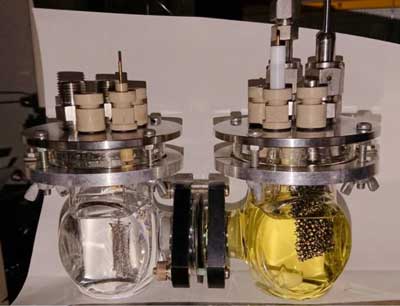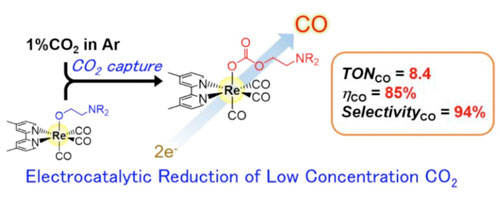| Nov 28, 2018 |
Scientists achieve direct electrocatalytic reduction of CO2, raising hopes for smart carbon capture
|
|
(Nanowerk News) Chemists at Tokyo Institute of Technology propose an innovative way to achieve carbon capture using a rhenium-based electrocatalytic system that is capable of reducing low-concentration CO2 (even 1%) with high selectivity and durability, which is a new potential technology to enable direct utilization of CO2 in exhaust gases from heavy industries.
|
|
Scientists are closer to finding effective ways to reduce CO2 levels – a vital part of responding to climate change and energy efficiency challenges.
|
|
A study led by Osamu Ishitani of the Department of Chemistry, Tokyo Tech now demonstrates the advantages of applying electrocatalysis1 to capture low-concentration CO2.
|
 |
| The CO2 reduction reaction takes place in the cathodic chamber shown on the right.
|
|
In their study published in Chemical Science ("Electrocatalytic reduction of low concentration CO2"), Ishitani and colleagues including Hiromu Kumagai and Tetsuya Nishikawa drew on decades of work on honing the capabilities of a rhenium-based catalyst, and demonstrated its ability to reduce low-concentration CO2 in the presence of a chemical called triethanolamine (TEOA).
|
|
Compared to many previous studies that have focused on reducing pure CO2, few have explored how to improve direct capture of low-concentration CO2 – a topic that warrants further investigation, considering that plants harness low concentrations of CO2 (about 400 ppm, that is 0.04% of the atmosphere) and exhaust gases from heavy industries typically contain low levels of CO2 (around 3-13%).
|
|
By avoiding the need for additional energy-consuming condensation processes, their strategy, if scaled up, could provide a more viable, environmentally friendly solution to CO2 capture in many settings.
|
 |
| Electrocatalytic reduction of low-concentration CO2 was achieved using a rhenium-based complex with high CO2-capturing ability.
|
|
In a series of experiments to assess electrocatalytic activity, the researchers found that at a CO2 concentration of 1%, the rhenium-based catalyst showed very high selectivity (94%) towards carbon monoxide (CO) formation.
|
|
A likely reason behind the high performance, the researchers say, is the efficient insertion of CO2 into the rhenium-oxygen bond.
|
|
The researchers aim to continue systematically investigating promising strategies to help reduce real-world CO2 levels.
|


